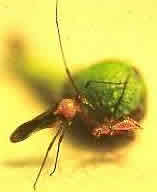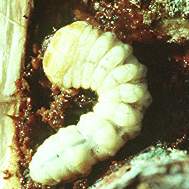|
29 October 2025
|
|
|
മലയാളം
|
|
|
|
|
|
Agriculture >
Plantation Crops > Cashew (Anacardium occidentale)
|
|
|
|
Plant protection
|
|
|
|
Pest and diseases
Tea mosquito bug ( Helopeltis antonnii )
|
This is the most serious pest affecting cashew. The pest usually appears with the
emergence of new flushes and panicle. Drying of inflorescence and dieback of shoots
are the symptoms. For control of tea mosquito bug, spray 0.003% Lamda
cyhalothrin or thiomethoxam 25 WG 0.2 g/litre or 0.05
% quinalphos. A rational rotation of insecticides would be desirable to counteract
the tendency of the pest to develop field resistance. Spraying may be done once,
twice or thrice depending upon necessity.
First spraying is to be given synchronizing with the emergence of new vegetative
flushes in October-November. The second spraying may be given synchronizing with
the commencement of panicle emergence in December-January. The third spraying may
be given at completion of flowering / initiation of fruit set in January-February.
|

|
Note: Avoid spraying at
Lamda cyhalothrin the time of flowering, as it is highly toxic to honey bees.
Cashew stem and root borer ( Placaederus ferrugineus
L. )

|
This is a serious pest, which is capable of destroying the cashew tree. Main symptoms
of attack are yellowing of leaves, drying of twigs, presence of holes at the base
of stem with exuding sap and frass.
Control
Swab the trunk and exposed roots with Chlorpyriphos 20 EC (0.2 %, 10 ml/l) .
To reduce the spread of infestation,it is essential to remove the dead trees and trees in advanced stage of infestation
at least once in 6 months. Prophylactic treatment by swabbing the trunk region (up
to 1 m height from the ground level) and exposed roots, with a suspension of mud
slurry or coal tar and kerosene (1:2) or 5 % neem oil twice a year
during March-April and November-December .
|
Fruit and nut borer ( Thylocoptila panrosama M. )
It is a pinkish dark actively moving caterpillar which bores into the tender apples
and nuts. Nuts are damaged in case of severe infestation. The caterpillars attack
the fruits at all stages and cause the shrivelling and premature fall of nuts. The
other minor pests of cashew include, leaf minor (Acrocercops syngramma M),
leaf and blossom webber (Lamida moncusalis Walker), shoot tip caterpillar
(Bypatima haligramma M) and leaf flower thrip (Scirtothrips dosatis Hood).
Diseases
Dieback or pink disease
This disease is prevalent in cashew plantations during rainy season. Main symptom
of attack is the appearance of white patches on branches followed by drying of twigs
from the tip.
Control
Chisel out the affected parts and apply Bordeaux paste. Give prophylactic sprays
of 1% Bordeaux mixture during May-June and October.
Note:
-
For grown up trees, 5 litres of spray fluid would be required at high volume discharge
rate and 2.5 litres at the low volume discharge rate. For spraying, rocker sprayer
with Hi-tree lance is preferable.
-
For low volume application, the concentration of the insecticides is to be maintained
at 0.1% for quinalphos and 0.2% for carbaryl and 0.06% for phosphamidon. It is difficult
to cover the entire canopy with low volume equipment. In such cases, the uncovered
upper canopy areas may be covered with rocker sprayer fitted with Hi-tree lance
system.
-
Dusting powder formulations are not recommended against tea mosquito bug.
-
Spray carbaryl 0.1% as a prophylaxis against pest infestation in nursery plants.
-
Spray Bordeaux mixture 1% to seedlings as a prophylactic measure against fungal
diseases.
Anthracnose and tea mosquito endemic area
(ad hoc recommendation)
|
Chemical
|
Concentration
|
Time/stage
|
|
Quinalphos 0.05%
+
Mancozeb 0.2%
|
2 ml/l (25 EC)
2 g/l
|
Flowering
|
|
Lamda cyhalothrin 0.003% + copper oxychloride 0.25
|
0.6 ml/l 5 EC
2 g/l %) WP
|
Flushing
|
Top
|
|
|
|
|
|